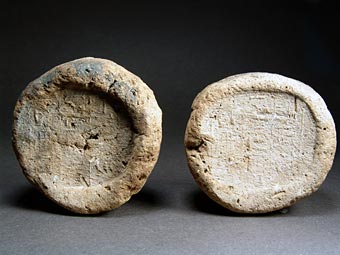|
These are the first known examples
for a Chief of the workhouses of Amun and for his wife, a Singer of Amun.
Their names can be provisionally read as Mehu and Tjajay until better preserved
cones appear.
The stamps read: (1) The Osiris-Khontamenti, (2) the chief of the workhouses of Amun, Mehu*,
[justified (?)], (3) the singer of Amun, Tjajay*, [justified (?)].
For the name Mehu, cf. Ranke 1935: p. 163, no. 13.
The chief of the workhouses of Amun was a low-ranking official involved in the
processing of staple foods. The number of known persons with this title
increases during the Ramesside Period. This is also the time where they can
afford their own decorated rock tombs.
Worn surface with barely discernible signs. Shaft cut off on both cones,
core black.
W. cone 8.4 cm (3.3 in)
W. seal impression 6.3 cm (2.5 in)
L. 3.3 cm (1.3 in)
Ex collection of Dr. Ulrich Müller, Switzerland, acquired between 1968 and
1978.
1200 USD |

Click above for larger
pictures ---------------- |
|
Literature: For the article dealing with this type follow the link to
academia.edu.
Ranke, Hermann. 1935. Die ägyptischen Personennamen. Vol. 1. Glückstadt/Hamburg.
Onstine, Suzanne L. 2001. The Role of the Chantress (Smayt) in Ancient Egypt.
Toronto.
Polz, Daniel. 1990. "Die Sna-Vorsteher des Neuen Reiches", in ZÄS 117
(1990), pp. 43-60.
|
